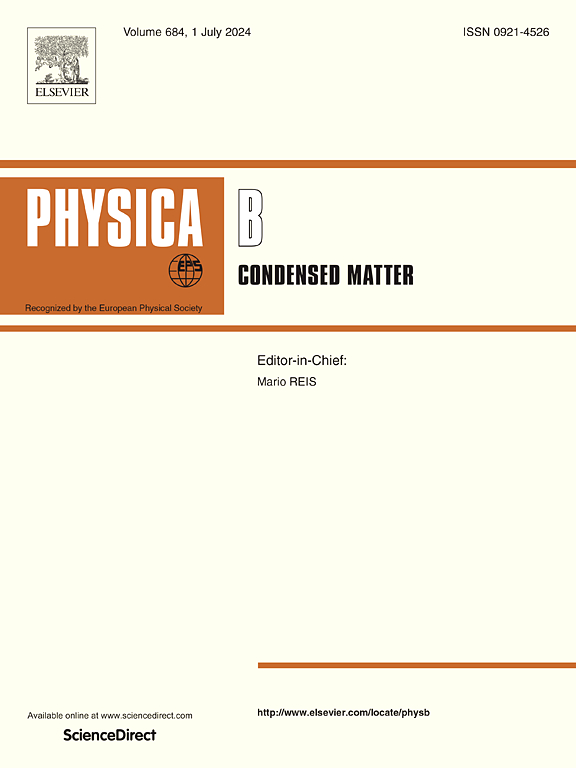A combined DFT and finite difference simulation study on hybrid halide perovskite-based solar cells
IF 2.8
3区 物理与天体物理
Q2 PHYSICS, CONDENSED MATTER
引用次数: 0
Abstract
This work reports the modelling and numerical estimation of the photovoltaic parameters of perovskite solar cells (PSCs) containing formamidinium lead iodide (FAPbI3) and formamidinium tin iodide (FASnI3) in the form of light active materials using SCAPS 1D software. The analysis is done by introducing diverse hole and electron transport materials and back metal contacts to identify the most appropriate device configuration that can deliver optimum photovoltaic output. The optoelectronic properties and the absorption spectra of the two compounds are estimated by DFT calculation using WIEN2k, which incorporates density functional theory (DFT) principles and are provided as input to SCAPS 1D to improve the accuracy of modelling study. For FAPbI3 as absorber material, the configuration FTO/IGZO/FAPbI3/NiO/Au shows the highest photovoltaic parameter exhibiting a power conversion efficiency (PCE) and fill factor (FF) of 19.75 % and 74.29 % respectively. With FASnI3 as the absorber material, FTO/PCBM/FASnI3/P3HT/Au gives a PCE and FF of 21.6 % and 67.74 % respectively. The work also includes the analysis of influence of defect density at the interface layers and series and shunt resistance on performance of above-mentioned device architectures to identify their limitations under real experimental conditions. The influence of various attributes of perovskite on the performance of the device is examined to determine their optimum values.
基于混合卤化物的过氧化物太阳能电池的 DFT 和有限差分模拟综合研究
这项研究利用 SCAPS 1D 软件,对含有碘化甲脒铅 (FAPbI3) 和碘化甲脒锡 (FASnI3) 作为光活性材料的过氧化物太阳能电池 (PSC) 的光伏参数进行了建模和数值估算。通过引入不同的空穴和电子传输材料以及背面金属触点进行分析,以确定最合适的器件配置,从而实现最佳的光伏输出。这两种化合物的光电特性和吸收光谱是通过使用 WIEN2k 进行 DFT 计算估算得出的,WIEN2k 结合了密度泛函理论(DFT)原理,并将其作为 SCAPS 1D 的输入,以提高建模研究的准确性。以 FAPbI3 作为吸收材料,FTO/IGZO/FAPbI3/NiO/Au 配置显示出最高的光伏参数,功率转换效率(PCE)和填充因子(FF)分别为 19.75 % 和 74.29 %。以 FASnI3 作为吸收材料,FTO/PCBM/FASnI3/P3HT/Au 的 PCE 和 FF 分别为 21.6 % 和 67.74 %。研究还分析了界面层的缺陷密度以及串联和并联电阻对上述器件结构性能的影响,以确定它们在实际实验条件下的局限性。研究还考察了过氧化物的各种属性对器件性能的影响,以确定其最佳值。
本文章由计算机程序翻译,如有差异,请以英文原文为准。
求助全文
约1分钟内获得全文
求助全文
来源期刊

Physica B-condensed Matter
物理-物理:凝聚态物理
CiteScore
4.90
自引率
7.10%
发文量
703
审稿时长
44 days
期刊介绍:
Physica B: Condensed Matter comprises all condensed matter and material physics that involve theoretical, computational and experimental work.
Papers should contain further developments and a proper discussion on the physics of experimental or theoretical results in one of the following areas:
-Magnetism
-Materials physics
-Nanostructures and nanomaterials
-Optics and optical materials
-Quantum materials
-Semiconductors
-Strongly correlated systems
-Superconductivity
-Surfaces and interfaces
 求助内容:
求助内容: 应助结果提醒方式:
应助结果提醒方式:


